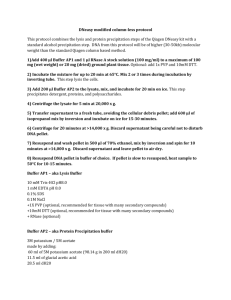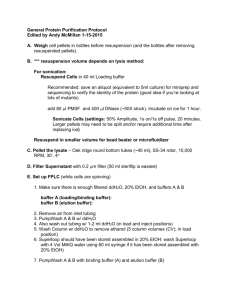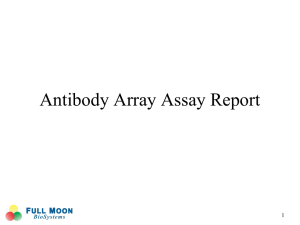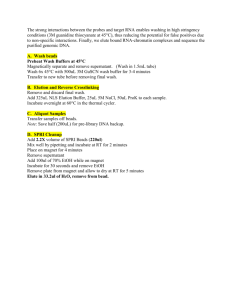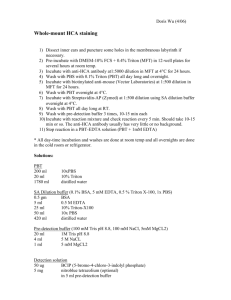Chromatin IP technique (Cells harvested by trypsinization)
advertisement
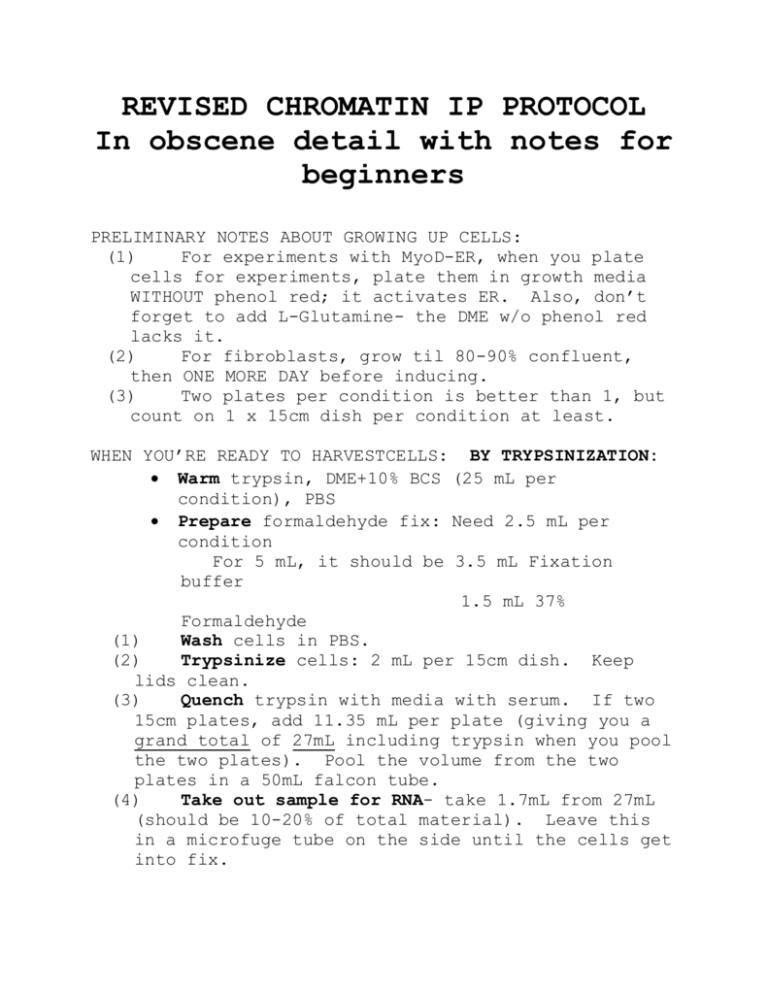
REVISED CHROMATIN IP PROTOCOL In obscene detail with notes for beginners PRELIMINARY NOTES ABOUT GROWING UP CELLS: (1) For experiments with MyoD-ER, when you plate cells for experiments, plate them in growth media WITHOUT phenol red; it activates ER. Also, don’t forget to add L-Glutamine- the DME w/o phenol red lacks it. (2) For fibroblasts, grow til 80-90% confluent, then ONE MORE DAY before inducing. (3) Two plates per condition is better than 1, but count on 1 x 15cm dish per condition at least. WHEN YOU’RE READY TO HARVESTCELLS: BY TRYPSINIZATION: Warm trypsin, DME+10% BCS (25 mL per condition), PBS Prepare formaldehyde fix: Need 2.5 mL per condition For 5 mL, it should be 3.5 mL Fixation buffer 1.5 mL 37% Formaldehyde (1) Wash cells in PBS. (2) Trypsinize cells: 2 mL per 15cm dish. Keep lids clean. (3) Quench trypsin with media with serum. If two 15cm plates, add 11.35 mL per plate (giving you a grand total of 27mL including trypsin when you pool the two plates). Pool the volume from the two plates in a 50mL falcon tube. (4) Take out sample for RNA- take 1.7mL from 27mL (should be 10-20% of total material). Leave this in a microfuge tube on the side until the cells get into fix. (5) Add fix (2.5mL to remaining 25mL media/cells), mix by inversion, and INCUBATE on bench for 30’, RT. If working with lots of samples, such that it takes several minutes to process all the plates, do one sample at a time from quench to fix, note the time lag between samples, and later, quench the fix at the same amount of time lag for the sample. *While cells are crosslinking, spin out cells in microfuge tube, decant sup, save pellets at –80ºC for eventual RNA preparation. (6) Quench fix with 1.4mL of 2.5M Glycine per 25mL media. Let sit for 3’. If staggered, put on ice until last sample is done. *NB: From this point on, try to minimize unnecessary contact between cell mix/chromatin and the container, as it sticks like no one’s business and you’ll only lose your sample. Use low bind tips, if available, and other such measures. (7) Spin in TC Room table top centrifuge at 1250 RPM for 5’. (8) Wash pellet in 40mL PBS, resuspending pellet by gentle vortexing, spin at 1250 RPM, 5’. Aspirate all but 0.5mL PBS with pellet. (9) Add 1mL of CELL WASH #2. Resuspend pellet and transfer to 15mL conical tube. Wash off stickage from 50mL tube with remaining 14 mL of cell WASH #2 buffer. Let stand in wash for 10’. Pellet by spinning 1800 RPM, 5’. (10) Add 2mL of CELL WASH #3. Resuspend pellet by vortexing, add remaining 13mL, invert to mix. Incubate, 10’. Spin 1800RPM, 5’. (11) Add 1mL of CELL WASH #3, resuspend, transfer to microfuge tube, pellet, decant sup. STOP HERE IF YOU WANT- FREEZE O/N, -80ºC. Bennett thinks he gets better yields if he proceeds to IP in one shot, but you may stop here, and you won’t die from it. (11b) Lyse pellet in 200L Dilution/Lysis buffer containing protease inhibitors, and if you’re looking at histone modifications, butyrate, too. Resuspend well, put on ice. (12) Sonicate each sample: 6x 20”, bath, setting 5. (13) Spin out debris from samples: 10’, 14,000 RPM, 4ºC. MEANWHILE…. (14) Wash dynabeads for pre-clearing: 3X TE washpipet to resuspend, let sit on ice 3-5’, collect beads, change wash. Resuspend last time in dilution buffer. Wash 75L bead slurry per sample, bring up in 75L, too. (15) Add soluble lysate to beads, keep cold pending BCA (4ºC, shaker). (16) Remove 20L for INPUT (store at –20ºC), (17) Take 1L for BCA assay. Add to 1500L BCA solution. I use a 1:10 dilution of this 1L and do a 2L and 4L reaction, and check the agreement of those…. BCA ASSAY- As per Pierce protocol. NOTE: Takes 30’ incubation PLUS cooling, PLUS reading. (18) Finally….SET UP IP’s. Use 500g (bare minimum, say your prayers)1000 g/ IP. Magnet out beads before, keep remaining chromatin after. Add 5L (MyoD) antibody, O/N, 4ºC. Nutating. NB: Some antibodies like to have some SDS around. MyoD polyclonal (6975B) likes to have 0.05% SDS, or 1:400 of 20% stock. Also add this SDS to subsequent IP buffers, until IP buffer 3, at the same concentration for best results. NEXT DAY…… (19) Prepare some beads for recovering the IP by washing them as before: 3 X 1mL TE, bring up in dilution buffer. Prepare 30L dynabeads/IP. (20) Add BSA (1:10) and herring sperm/calf thymus DNA (1:50) to dynabead blocking solution. Incubate at 4ºC, nutating, 10’. (21) Add beads to IP, incubate 4ºC, nutating, 1 hr. For the following washes, add 1mL, pipet to resuspend, incubate 3-5’ on ice, collect beads, change the wash. Also, once you get to TE wash #1, use aerosol tips and treat the samples like PCR samples, as far as contamination care goes. Also, after the first TE, which will have no detergent in it, the beads are considerably less adherent to the wall of the tube, so aspirate with a pipetman to be sure that if you suck something out, you can put it back. (22) TE, When Collect WASH BEADS: (IP Wash) #2, #2, #2, #3, #3, #3, TE, TE. in last TE wash, transfer to a fresh tube. the beads. (23) ELUTE with 2 x 250L Elution buffer, 15’, 4ºC, shaking. (24) Bring up the input sample volume to 500L with Elution buffer. (25) Add 20L of 5M NaCl to elution volume, mix well, and incubate at 65ºC, O/N (4-16hr.) to decrosslink. NEXT DAY…. (26) Add to each sample: 10 L 0.5M EDTA, pH 8.0 20L 1.0M Tris, pH 6.5 5 L of Proteinase K (@50 mg/mL) INCUBATE at 45-55ºC for 2 hrs. (27) CLEAN UP* the digestion mix with a QIAGEN PCR Cleanup Kit. *Add the reaction volume to 5X the volume of Qiagen Buffer PB, mix well, and purify on a PCR purification column. Wash as directed by kit. Elute in 40L-50L of ChIP RESUSPENSION BUFFER (3mM Tris, pH 8.0, 0.1mM EDTA). (28) Take the OD of input samples, and get ready to set up the PCR’s. Store samples at –20ºC when not in use. *You may not have enough IP sample to detect an accurate OD. I usually start my ChIP PCR’s with 2L of my elution per reaction and see how it goes. SOLUTIONS FOR CHROMATIN IP PROTOCOL 10X FORMALDEHYDE FIXATION BUFFER reagent 50mM HEPES, pH 8.0 1mM EDTA, pH 8.0 0.5mM EGTA 100mM NaCl stock 1.0M 0.5M 0.5M 5.0M volume (100mL) 5mL 200L 100L 2mL *Add 37% Formaldehyde FRESH before use…. Buffer + 1.5 mL 37% Formaldehyde Chromatin CELL WASH #2 BUFFER reagent stock volume (500mL) 10mM Tris, pH 8.0 1.0M 5mL 10mM EDTA, pH 8.0 0.5M 10mL 0.5mM EGTA 0.5M 500L 0.25% Triton-X 20% 6.25mL 3.5 mL 10X volume (100mL) 1mL 2mL 100L 1.25mL *Add Sodium Butyrate FRESH before use, if doing an acetylation-type IP… 10mM Butyrate 0.25M 4mL 20mL Chromatin CELL WASH #3 BUFFER reagent stock volume (100mL) volume (500mL) 10mM Tris, pH 8.0 1.0M 1mL 5mL 1mM EDTA, pH 8.0 1mL 0.5mM EGTA 500L 200mM NaCl 20mL 0.5M 200L 0.5M 100L 5M 4mL *Add Sodium Butyrate, as above, if needed. 4mL 20mL ELUTION BUFFER stock (100mL) 1% SDS 0.1M NaHCO3 volume 20% (1mol=84.01g) 0.84g 5mL ---ad 100 mL with H20 “DILUTION”/LYSIS BUFFER reagent stock volume (100mL) 1.1% Triton-X 20% 5.6mL 4mM EDTA, pH 8.0 0.5M 800L 40mM Tris, pH 8.1 1.0M 4.0mL 300mM NaCl 5.0M 6.0mL -------------------------------------------------------------------------Inhibitor Cocktail 7X 1:7 (14.29mL) volume (2mL) 111L 16L 80L 120L -------------------------286L (from Boehringer pellet) --------------------------------------------------------------------------------------------------*10mM Butyrate, if needed 0.25M 80L 4.0mL +1.307mL H20 ad 100 mL with H20 2.0mL total IP WASH BUFFER #2 reagent stock volume (200mL) 1% Triton-X 20% 10mL 2mM EDTA, pH 8.0 0.5M 800L 20mM Tris, pH 8.1 1.0M 4mL 500mM NaCl 5.0M 20mL H20 ---165mL volume (100mL) 5mL 400L 2mL 10mL 82.6mL **Add SDS as needed/preferred by the specific antibody (MyoD IP- add SDS to 0.5%) IP WASH BUFFER #3 reagent volume (200mL) stock volume (100mL) 0.25M LiCl 5M 10mL 1% NP-40 20% 10mL 1% Na-Deoxycholate 20% 10mL 1mM EDTA, pH 8.0 0.5M 400L 10mM Tris, pH 8.1 1.0M 2mL H20 ---167.6mL 5mL 5mL 5mL 200L 1mL 83.8mL Additional notes… I check products on 5.5% polyacrylamide gels, 1X TBE, 5% glycerol. Run these at 60mAmps for 3 hours. A typical PCR reaction looks like this: 2L IP sample 2L 10x PCR buffer 2L dNTP mix (10mM each) 2L DMSO 0.2L BSA (100X) 25pmol each primer per reaction 1.6L Mg++ (50mM) 0.33L Platinum Taq 0.1L dCTP WHEN YOU’RE READY TO HARVESTCELLS: BY SCRAPING Warm DM, DME+0.5%HS+insulin+transferrin (25 mL per condition), PBS Prepare formaldehyde fix: Need 2.5 mL per condition For 5 mL, it should be 3.5 mL Fixation buffer 1.5 mL 37% Formaldehyde SCRAPING PROTOCOL… Dump the media from the cells from ONE CONDITION into a conical tube and KEEP this media. Take out sample for RNA - To keep some lysate for eventual RNA analysis, scrape approximately 2 squares from the 15cm plate grid of cells in remaining media (usually works out to be about 0.5mL). (spin down pellet, decant liquid, store at -80ºC) Add back same media gently to the plate(s) EXCEPT the 0H high serum plate. To this plate, add back 25mL of warm, DM with insulin and transferrin but no -estradiol. Add fix- 2.5mL fix solution per plate, mix, incubate on benchtop, RT, 30’. Quench fix with 1.4mL of 2.5M Glycine per 25mL media. Let sit for 3’. If staggered, put on ice until last sample is done. FOR THE REST OF THE WASH STEPS, it is better to do them in the cold room and leave the plates incubating there. Use the same washes and wash times as for the trypsinization protocol, EXCEPT after a wash/fix step, just dump off the buffer, remove the last bit of solution with a pipet, add the next wash, let sit at 4ºC for 10’, then dump stuff…. After the last wash, scrape the cells with a cell scraper, collect, pellet, decant sup. And proceed…..

